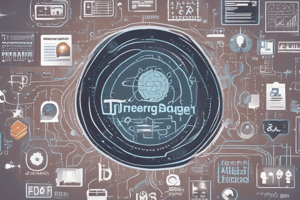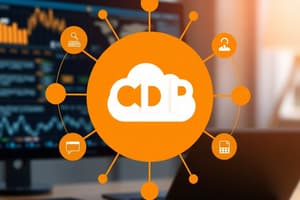Podcast
Questions and Answers
What is the primary purpose of a Customer Data Platform?
What is the primary purpose of a Customer Data Platform?
- To consolidate customer data from multiple sources (correct)
- To create marketing content
- To manage customer relationships
- To target digital advertising
Which of the following is a key feature of a CDP?
Which of the following is a key feature of a CDP?
- Real-time data updates (correct)
- Automating payroll
- Inventory management
- Generating sales forecasts
How does a CDP enhance customer insight?
How does a CDP enhance customer insight?
- By using data solely from surveys
- By analyzing data from various stages of the customer journey (correct)
- By focusing solely on sales data
- By providing generic customer profiles
What is a significant benefit of using a CDP for marketing teams?
What is a significant benefit of using a CDP for marketing teams?
In what scenario would a CDP be most beneficial?
In what scenario would a CDP be most beneficial?
What challenge is commonly faced when implementing a CDP?
What challenge is commonly faced when implementing a CDP?
How does a CDP compare to a CRM?
How does a CDP compare to a CRM?
Which of the following represents a use case of a CDP?
Which of the following represents a use case of a CDP?
Flashcards are hidden until you start studying
Study Notes
CDP (Customer Data Platform)
-
Definition:
- A CDP is a centralized database that consolidates customer data from multiple sources into a single view.
-
Key Features:
- Data Integration:
- Gathers data from various channels (web, email, CRM, etc.).
- Unified Customer Profiles:
- Creates comprehensive profiles by merging data from different sources.
- Real-Time Data:
- Updates customer information in real-time for timely insights.
- Segmentation:
- Enables advanced audience segmentation for targeted marketing.
- Data Integration:
-
Benefits:
- Improved Marketing Personalization:
- Tailors messaging based on customer behavior and preferences.
- Enhanced Customer Insights:
- Provides a deeper understanding of customer journeys and interactions.
- Increased Efficiency:
- Streamlines data access and usage across marketing teams.
- Data Privacy Compliance:
- Assists in managing and securing customer data in compliance with regulations.
- Improved Marketing Personalization:
-
Use Cases:
- Targeted Campaigns:
- Launch campaigns based on specific customer behaviors or demographics.
- Customer Retention:
- Identify at-risk customers and implement retention strategies.
- Cross-Selling and Upselling:
- Analyze purchase history to suggest relevant products.
- Targeted Campaigns:
-
CDP vs. Other Data Platforms:
- CRM (Customer Relationship Management):
- Focuses on managing customer relationships, often more sales-oriented.
- DMP (Data Management Platform):
- Primarily used for managing and targeting digital advertising, generally anonymized data.
- BI (Business Intelligence) Tools:
- Used for analysis and reporting, lacks real-time customer profile insights.
- CRM (Customer Relationship Management):
-
Challenges:
- Data Quality:
- Ensuring accuracy and consistency of data from multiple sources.
- Integration Complexity:
- Integrating with existing systems and databases can be complex and resource-intensive.
- Privacy Concerns:
- Navigating regulations like GDPR and CCPA regarding customer data handling.
- Data Quality:
-
Market Landscape:
- Growing adoption across industries such as retail, finance, and healthcare.
- Increasing focus on customer experience drives demand for CDPs.
Customer Data Platform (CDP)
- A CDP centralizes customer data from various sources for a consolidated view.
- Data integration collects information from channels like web, email, and CRM.
- It creates unified customer profiles by amalgamating data from different platforms.
- Customer information updates in real-time, providing timely insights for marketers.
- Advanced audience segmentation is facilitated for targeted marketing strategies.
Benefits of CDPs
- Enables improved marketing personalization by aligning messaging with customer preferences and behavior.
- Offers enhanced customer insights that lead to a better understanding of interactions and journeys.
- Increases efficiency by streamlining data access and utilization across marketing teams.
- Helps ensure data privacy compliance, addressing regulatory requirements for data management.
Use Cases for CDPs
- Facilitates targeted campaigns that leverage specific customer behavior or demographics.
- Assists in customer retention by identifying customers at risk and implementing strategies to retain them.
- Supports cross-selling and upselling through analysis of purchase histories to recommend relevant products.
Comparing CDPs with Other Data Platforms
- CRM: Primarily focuses on managing customer relationships and is more sales-oriented.
- DMP: Used for managing and targeting digital advertising, typically relies on anonymized data.
- BI Tools: Designed for analysis and reporting but lack the capability for real-time customer profile insights.
Challenges Facing CDPs
- Ensuring data quality requires accuracy and consistency across multiple sources.
- Integration challenges arise when connecting with existing systems and databases can be complex.
- Privacy concerns necessitate careful navigation of regulations like GDPR and CCPA regarding customer data usage.
Market Landscape
- Increasing adoption of CDPs across various industries, including retail, finance, and healthcare.
- Growing emphasis on enhancing customer experience is driving the demand for CDPs.
Studying That Suits You
Use AI to generate personalized quizzes and flashcards to suit your learning preferences.




